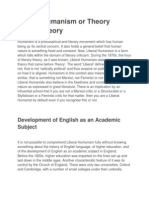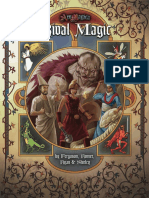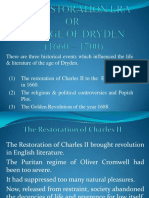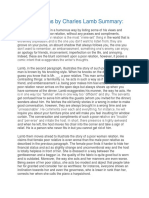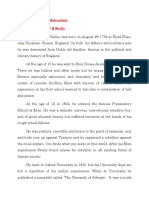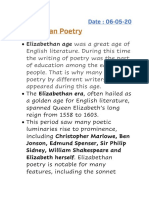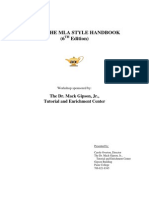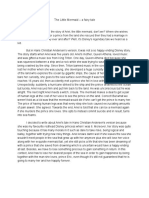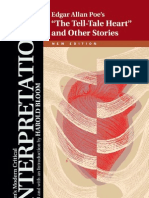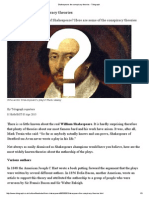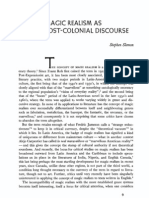Professional Documents
Culture Documents
Development of The Sonnet
Development of The Sonnet
Uploaded by
Fahiem ChaucerOriginal Description:
Original Title
Copyright
Available Formats
Share this document
Did you find this document useful?
Is this content inappropriate?
Report this DocumentCopyright:
Available Formats
Development of The Sonnet
Development of The Sonnet
Uploaded by
Fahiem ChaucerCopyright:
Available Formats
Development of the Sonnet
A sonnet is a one-stanza poem of fourteen lines which originated in Italy. The term sonnet derives from the Italian word sonetto, meaning "little song", and by the thirteenth century it signified a poem of fourteen lines that follows a strict rhyme scheme and specific structure. It was developed by Francesco Petrarch and thats why the Italian sonnet came to be known as the "Petrarchan" sonnet. But it wasnt introduced into English poetry until the sixteenth century. From there, Shakespeare made the sonnet famous in England and others followed his lead. Writers of sonnets are sometimes called "sonneteers". Among the best known English sonnet writers are: John Donne, John Milton, William Wordsworth and William Shakespeare, who wrote 154 of them (not including those that appear in his plays). English sonnet-writers almost always used iambic pentameter as their standard metrical pattern in which a pattern of an unstressed syllable followed by a stressed syllable is repeated five times. The sonnet was introduced to England by Sir Thomas Wyatt (1502 - 1542) and Henry Howard, Earl of Surrey (1507 - 1547) in the sixteenth century. Sir Thomas Wyatt introduced the Petrarchan sonnet which consists of an octave and a sestet. While Henry Howard, Earl of Surrey introduced the blank verse and the English sonnet or the Shakespearean sonnet, because Shakespeare was the one who used it most, which consists of three quatrains and a closing couplet. And they have the credit of adjusting the rhyme scheme and the meter to accommodate the English language. This model had a strong influence on many English poets like: Edmund Spencer, Philip Sidney and of course Shakespeare. The Petrarchan sonnet or the Italian sonnet is divided into two parts, the octave and the sestet. The octave is eight lines long and its rhyme scheme is ABBAABBA, while the sestet is six lines long and its rhyme scheme is either CDCDCD or CDECDE. There is usually a pause or break in thought between the octave and sestet called the Volta, or turn. Traditionally, the octave presents the
theme, raises an issue or doubt and the sestet answers the question, resolves the problem, or drives home the poem's point. Its written in iambic pentameter. The first Petrarchan sonnets in English were written by Sir Thomas Wyatt and Henry Howard, Earl of Surrey. Other English poets including John Milton, Thomas Gray and William Wordsworth. The Shakespearean sonnet or the English sonnet is named after Shakespeare, not because he was the first to write in this form but because he became its most famous practitioner. Instead of the octave and the sestet found in the Petrarchan sonnet, The Shakespearean sonnet consists of fourteen lines structured as three quatrains (four lines) and a closing couplet (two lines). The Shakespearean sonnet has the rhyme scheme ABAB CDCD EFEF GG. The problem is usually developed in the first three quatrains, each quatrain with a new idea growing out of the previous one. The Volta or the turn usually comes in the couplet, and usually summarizes the theme of the poem or introduces a fresh new look at the theme. Like the Petrarchan sonnet its written in iambic pentameter. The Spenserian sonnet is named after Edmund Spenser. Like the Shakespearean sonnet, Spensers sonnets generally observe the 3 quatrain plus couplet model in which the rhyme scheme is ABAB, BCBC, CDCD, EE. Unlike the Petrarchan sonnet, the Spenserian sonnet does not appear to require that the initial octave set up a problem that the closing sestet answers. Instead, the form is treated as three quatrains connected by the interlocking rhyme scheme and closed by a couplet. The Modern sonnet With the advent of free verse, the sonnet was seen as somewhat old-fashioned and fell out of use for a time among some schools of poets. However, a number of modern poets continued to use the form. Modern Sonnets do not follow a specific pattern or rhyme scheme. They have the look and feel of free form poetry, but Sonnets do have certain characteristics that classify them in that category.
You might also like
- Characteristics of 16th Century English PoetryDocument3 pagesCharacteristics of 16th Century English Poetrydara Hinari100% (2)
- Liberal Humanism or Theory Before TheoryDocument14 pagesLiberal Humanism or Theory Before TheoryVijeta Budhiraja92% (52)
- What Is A SonnetDocument6 pagesWhat Is A SonnetMaria Lourdez Bayan100% (2)
- Details of Study Notes UGC-NET: (Unit) - 9:literary Theory Post World War 2Document1 pageDetails of Study Notes UGC-NET: (Unit) - 9:literary Theory Post World War 2Diwakar RajputNo ratings yet
- Assaignment On Metaphysical PoetryDocument58 pagesAssaignment On Metaphysical PoetrySafayet Asif100% (1)
- The Hero ofDocument5 pagesThe Hero ofkhushnood aliNo ratings yet
- COMPARISION OF JOHN DRYDEN AND SIR PHILIP SIDNEY AS A CRITIC WITH RESPECT TO THEIR ESSAYS - Docx by LavanyaDocument4 pagesCOMPARISION OF JOHN DRYDEN AND SIR PHILIP SIDNEY AS A CRITIC WITH RESPECT TO THEIR ESSAYS - Docx by LavanyaLavanyaNo ratings yet
- Introduction To Consecutive InterpretingDocument21 pagesIntroduction To Consecutive InterpretingFahiem Chaucer100% (3)
- Rival Magic PDFDocument144 pagesRival Magic PDFguanamarioch100% (4)
- S T ColeridgeDocument4 pagesS T ColeridgeRavindra SinghNo ratings yet
- Renaissance and ShakespeareDocument8 pagesRenaissance and ShakespeareCansu BahadırNo ratings yet
- Sidney Sonnet 1 NotesDocument7 pagesSidney Sonnet 1 NotesRhea WyntersNo ratings yet
- An Essay of Dramatic PoesyDocument2 pagesAn Essay of Dramatic PoesyWaqarAli100% (3)
- Joseph Andrews - Summary and Analysis - Author's Preface - CliffsNotesDocument2 pagesJoseph Andrews - Summary and Analysis - Author's Preface - CliffsNoteskhushnood ali100% (2)
- Fate and Chance in Novel TessDocument4 pagesFate and Chance in Novel TessSyed Qais100% (2)
- The Origin and Function of DramaDocument7 pagesThe Origin and Function of DramaLhita Malota100% (1)
- Robert Frost As A Regional PoetDocument5 pagesRobert Frost As A Regional Poetnero daunaxil50% (2)
- 4 - The Rise of The Middle Class - The Barren AgeDocument2 pages4 - The Rise of The Middle Class - The Barren AgeOry BelliuNo ratings yet
- Contemporaries of ChaucerDocument3 pagesContemporaries of ChaucerGarret RajaNo ratings yet
- Anglo Saxon PoetryDocument5 pagesAnglo Saxon Poetryjohnmc120% (1)
- The English Novel of The 18th CenturyDocument9 pagesThe English Novel of The 18th Centuryshoaib625100% (1)
- 100%metaphysical Poet and Their ContributionDocument2 pages100%metaphysical Poet and Their ContributionMd Masud RanaNo ratings yet
- THE AGE OF DRYDEN 29042021 020042pmDocument22 pagesTHE AGE OF DRYDEN 29042021 020042pmTehneat Arshad100% (1)
- English Literature - 2009Document4 pagesEnglish Literature - 2009Jawad Ur Rehman Bhutta100% (1)
- Origins of DramaDocument4 pagesOrigins of DramaMichelle RangesNo ratings yet
- Anglo Saxon PeriodDocument10 pagesAnglo Saxon PeriodPicturing PakistanNo ratings yet
- Poor RelationsDocument3 pagesPoor RelationsWaseem Iqbal83% (6)
- Alexander Pope As A PoetDocument2 pagesAlexander Pope As A PoetSana Noor100% (1)
- University WitsDocument6 pagesUniversity WitsSiddhartha Singh100% (2)
- Exile (From Rough Passage) by R200225111102022222Document19 pagesExile (From Rough Passage) by R200225111102022222Bishnoi KANHAIYANo ratings yet
- Elizabethan Age PDF DownloadDocument6 pagesElizabethan Age PDF DownloadBlack alphaNo ratings yet
- Final Notation Asma SheikhDocument5 pagesFinal Notation Asma Sheikhnoor100% (1)
- Puritan PoetryDocument4 pagesPuritan PoetryFakhar FarooqNo ratings yet
- Post-Colonial Feminist Approach in A Passage To IndiaDocument5 pagesPost-Colonial Feminist Approach in A Passage To IndiaWaseem AliNo ratings yet
- Characteristics of Shakespearean TragedyDocument5 pagesCharacteristics of Shakespearean TragedyIrfan Baloch75% (4)
- Short Biography of ShellyDocument2 pagesShort Biography of ShellySr Chandrodaya JNo ratings yet
- Plato's Contribution As A CriticDocument11 pagesPlato's Contribution As A CriticHemang J. BhattNo ratings yet
- History of English Literature Objective Questions Including Tag QuestionsDocument30 pagesHistory of English Literature Objective Questions Including Tag QuestionsSandeep Sharma81% (36)
- Fluency Devices/Phonetics/LinguisticsDocument1 pageFluency Devices/Phonetics/LinguisticsGhulam Muhammad Abbasi60% (5)
- Augustan AgeDocument2 pagesAugustan AgeZiaurrehman AbbasiNo ratings yet
- A Passage To India - Analysis of Major CharactersDocument3 pagesA Passage To India - Analysis of Major CharactersAlexandra Moisi100% (3)
- Short QuestionsDocument25 pagesShort QuestionsMuhammad IsmailNo ratings yet
- Types of NovelsDocument6 pagesTypes of NovelsRangothri Sreenivasa SubramanyamNo ratings yet
- A Study From A Colonial and Postcolonial Perspective of E. M. Forster's A Passage To IndiaDocument21 pagesA Study From A Colonial and Postcolonial Perspective of E. M. Forster's A Passage To IndiaYousif OthmanNo ratings yet
- Betrand Russell 1872-1970Document5 pagesBetrand Russell 1872-1970Bint e Ashraf100% (1)
- Dramatic MonologueDocument4 pagesDramatic MonologuebushreeNo ratings yet
- Survey The Prominent Literary Trends of The Victorian Age.Document7 pagesSurvey The Prominent Literary Trends of The Victorian Age.নিজন্ম সূর্য89% (9)
- An Essay of Dramatic PoesyDocument6 pagesAn Essay of Dramatic PoesyFady Ezzat 1No ratings yet
- Renaissance LiteratureDocument9 pagesRenaissance LiteratureJescel Aguilar Aquino100% (1)
- Disturbed NightsDocument8 pagesDisturbed NightsawtshfhdNo ratings yet
- Allamah Iqbal's 5 LettersDocument13 pagesAllamah Iqbal's 5 LettersUmerBukhariNo ratings yet
- Ijciss V2i42024871Document10 pagesIjciss V2i42024871Javed MohsinNo ratings yet
- Augustan AgeDocument7 pagesAugustan Agea_perfect_circle100% (1)
- Sailing To Byzantium by WDocument2 pagesSailing To Byzantium by WTANBIR RAHAMANNo ratings yet
- Change of Patrons: Elizabethan AgeDocument2 pagesChange of Patrons: Elizabethan AgeMEENUPAUNIKAR100% (1)
- Elizabethan Poetry: Elizabethan Age Was A Great Age ofDocument10 pagesElizabethan Poetry: Elizabethan Age Was A Great Age ofChishmish Doll100% (1)
- On The Value of Scepticism Literary AnalysisDocument3 pagesOn The Value of Scepticism Literary AnalysisSyeda Rida Zahra100% (2)
- Unification SensibilityDocument3 pagesUnification SensibilityAhsan LavaNo ratings yet
- The Origin and Development of English NovelDocument16 pagesThe Origin and Development of English NovelFaisal Jahangeer100% (1)
- Sociability of ManDocument6 pagesSociability of ManHammad Ali100% (1)
- Notes An Essay On Dramatic PoesieDocument9 pagesNotes An Essay On Dramatic PoesieChinmoyee SurNo ratings yet
- Modern DramaDocument24 pagesModern DramaNabeel Riasat Riasat AliNo ratings yet
- сонети і ШекспірDocument3 pagesсонети і ШекспірDaria BorovetsNo ratings yet
- Modern Humanities Research Association Austrian StudiesDocument8 pagesModern Humanities Research Association Austrian StudiesFahiem ChaucerNo ratings yet
- The World of The Theatre: Compact Performer - Culture & LiteratureDocument11 pagesThe World of The Theatre: Compact Performer - Culture & LiteratureFahiem ChaucerNo ratings yet
- More ExamplesDocument2 pagesMore ExamplesFahiem ChaucerNo ratings yet
- Introduction To Simultaneous InterpretingDocument4 pagesIntroduction To Simultaneous InterpretingFahiem ChaucerNo ratings yet
- Introduction To Simultaneous InterpretingDocument4 pagesIntroduction To Simultaneous InterpretingFahiem ChaucerNo ratings yet
- The Three Unities - DramaDocument6 pagesThe Three Unities - DramaFahiem ChaucerNo ratings yet
- Mohammed Awad Al-Awfi: Prepared byDocument8 pagesMohammed Awad Al-Awfi: Prepared byFahiem ChaucerNo ratings yet
- Prepositions With Nouns, Adjectives and VerbsDocument7 pagesPrepositions With Nouns, Adjectives and VerbsFahiem ChaucerNo ratings yet
- قواعدDocument135 pagesقواعدwaa2011No ratings yet
- Writing A Bibliography: MLA Format: BasicsDocument3 pagesWriting A Bibliography: MLA Format: BasicsFahiem ChaucerNo ratings yet
- Place: Speaker A . Speaker B .. Function: . Place: Speaker A . Speaker B .. FunctionDocument5 pagesPlace: Speaker A . Speaker B .. Function: . Place: Speaker A . Speaker B .. FunctionFahiem ChaucerNo ratings yet
- Types of Poetry - KasDocument2 pagesTypes of Poetry - KasFahiem ChaucerNo ratings yet
- NumbersDocument2 pagesNumbersFahiem ChaucerNo ratings yet
- DOCTOR RN RAI Theories of DramaDocument8 pagesDOCTOR RN RAI Theories of Dramanueva_madreNo ratings yet
- Water PollutionDocument5 pagesWater PollutionFahiem ChaucerNo ratings yet
- Theater History I IDocument31 pagesTheater History I IxalicenguyenNo ratings yet
- Using The Mla Style Handbook (6 Edition) : The Dr. Mack Gipson, JR., Tutorial and Enrichment CenterDocument14 pagesUsing The Mla Style Handbook (6 Edition) : The Dr. Mack Gipson, JR., Tutorial and Enrichment CenterFahiem ChaucerNo ratings yet
- Part II Modern Drama 2012-13Document8 pagesPart II Modern Drama 2012-13Fahiem ChaucerNo ratings yet
- Pismeni Ispit Iz Engleskog JezikaDocument6 pagesPismeni Ispit Iz Engleskog JezikaIva CelebicNo ratings yet
- BW 9A-21 NicolaDocument1 pageBW 9A-21 Nicola9A 21 Nicola Anastasia Prayugo SutomoNo ratings yet
- 370 Grammar PPTDocument19 pages370 Grammar PPTDani Nugroho100% (1)
- The Messapic Klaohizis FormulaDocument10 pagesThe Messapic Klaohizis FormulabboyflipperNo ratings yet
- Creative Writing - How To Develo - Adele RametDocument137 pagesCreative Writing - How To Develo - Adele RametSecretx Sahydian100% (1)
- African LiteratureDocument7 pagesAfrican LiteratureEmma DianaNo ratings yet
- Foreshadowing The LotteryDocument2 pagesForeshadowing The LotteryJoseph CabadongaNo ratings yet
- Consumption, Machines and Black HolesDocument4 pagesConsumption, Machines and Black HolesNadina ŢărucăNo ratings yet
- Book Report Harry Potter and The Prisoner of AzkabanDocument6 pagesBook Report Harry Potter and The Prisoner of AzkabanCynthia GrantNo ratings yet
- Novel AnalysisDocument5 pagesNovel AnalysisEvelyn Ivana AudreyNo ratings yet
- The Tell-Tale Heart and Other Stories - Edgar Allan Poe (Bloom's Modern Critical Interpretations)Document221 pagesThe Tell-Tale Heart and Other Stories - Edgar Allan Poe (Bloom's Modern Critical Interpretations)Tagged Tad88% (8)
- Movie 2108Document18 pagesMovie 2108ASHUTOSH ATHAVALENo ratings yet
- An Introduction To The Odyssey: Feature MenuDocument24 pagesAn Introduction To The Odyssey: Feature MenuNicolae Ionel Valentin100% (1)
- Shakespeare The Conspiracy Theories - TelegraphDocument3 pagesShakespeare The Conspiracy Theories - Telegraphapi-291592636No ratings yet
- REVIEWS FINAL Nov17 PDFDocument47 pagesREVIEWS FINAL Nov17 PDFJ MorenoNo ratings yet
- 21st Century Literature - Module 3Document13 pages21st Century Literature - Module 3KrysNo ratings yet
- Oops I Did It Again Guitar TabDocument5 pagesOops I Did It Again Guitar TabDemi MaNo ratings yet
- Original Narrative: True Friends: Name: Ahmad Faiz Alamsyah 201810110311234 Name: Fachry Ahsany 201810110311221Document3 pagesOriginal Narrative: True Friends: Name: Ahmad Faiz Alamsyah 201810110311234 Name: Fachry Ahsany 201810110311221Ahmad Faiz AlamsyahNo ratings yet
- 6th Grade - Unit 5 MYPDocument43 pages6th Grade - Unit 5 MYPHenrique Schmidt PretoNo ratings yet
- (Author) : Cormac MccarthyDocument9 pages(Author) : Cormac MccarthycanareNo ratings yet
- Revolution 2020Document38 pagesRevolution 2020Mansi GajjarNo ratings yet
- Novelette Review Lloyd AndapDocument5 pagesNovelette Review Lloyd AndapSkylar Jansen Clay AndapNo ratings yet
- Doctor Magnethands: A Game For Three or More Drunk PeopleDocument2 pagesDoctor Magnethands: A Game For Three or More Drunk PeopleTwogunkidNo ratings yet
- Knowledge OrganiserDocument2 pagesKnowledge Organisershazia TariqNo ratings yet
- Grade 11 Creative WritingDocument4 pagesGrade 11 Creative WritingShira Towa UirusuNo ratings yet
- Magical Realism As Post-Colonial DiscourseDocument16 pagesMagical Realism As Post-Colonial Discourseleonardo_2006100% (2)
- Untitled 122Document13 pagesUntitled 122alamf1100% (2)
- (Book) Various Artists - Piano Solos Film Music - The Costume Drama CollectionDocument96 pages(Book) Various Artists - Piano Solos Film Music - The Costume Drama CollectionAlanna100% (9)

